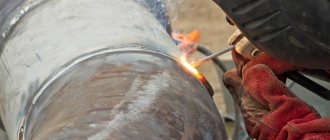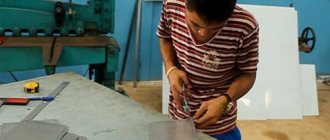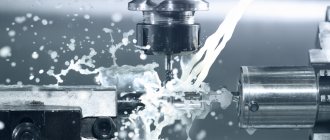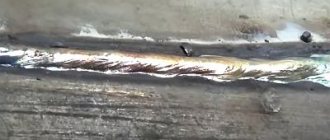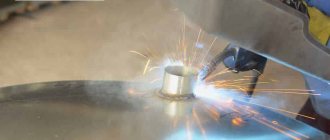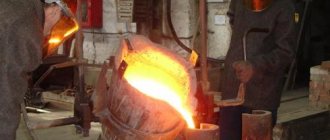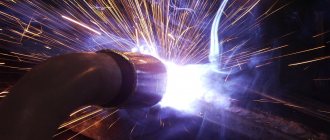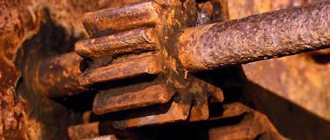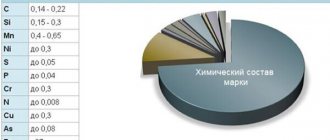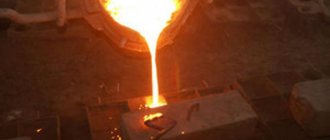Tips on how to distinguish galvanized steel from aluminum, stainless steel and non-galvanized steel.
When manufacturing metal containers or structures (for example, the widespread construction of hangars or warehouses), the quality of the metal, and, in particular, its corrosion resistance, is important. For this purpose, steels with protective (usually zinc) coatings, as well as stainless steel and aluminum are widely used. How can you distinguish between these metals and protect yourself from the actions of unscrupulous dealers?
Distinguishing aluminum from galvanization
In order to reduce the load on supporting structures, they are often made of aluminum. It is easy to distinguish aluminum from galvanized steel, especially if the buyer is not presented with a finished assembly, but with blanks made from rolled sheets or profiles. Main methods:
- By density/weight. The density of aluminum (2700 kg/m3) is almost three times less than the density of steel (7600...7900 kg/m3).
- In terms of surface hardness, aluminum is softer, and when scratched it will leave a deeper groove on a smooth surface.
- According to the effect on the tissue organs of the fingers. The thinnest film of aluminum dioxide upon frictional contact with wet skin of the hands will leave particles of aluminum on the surface of the fingers. When you touch them to a sheet of clean paper or cardboard, dark gray stripes will remain on it.
Externally, aluminum looks more silvery than steel, especially hot-rolled steel.
We distinguish between galvanized and non-galvanized steel
Both stainless steel and galvanized steel are characterized by good resistance to corrosion, so for short service life of structures (up to 10 years), the lower price of galvanized steel can be the decisive choice. It’s a different matter if the design is designed for a shorter period of use, and there is a reason to use ordinary steel. In such cases, it may be necessary to distinguish galvanized steel from non-galvanized steel.
A simple test will help you determine the difference between regular and galvanized steel:
- Prepare a solution of three parts table salt (not iodized!) and one part warm water.
- Dip a clean rag/cloth napkin into the solution and wipe the surface of the steel being tested with it.
- We keep the sample for 24 hours in a normal room at room temperature (you can’t leave it in the sun).
- We inspect the sample: if there are no traces of rust on it, and the surface texture is not uniform in the treated and untreated areas, then this is galvanized steel.
The basis of the test is that as a result of galvanic galvanizing - hot or cold - zinc actively penetrates deep into the base metal, introducing itself into its structure, which acquires anti-corrosion resistance. Ordinary steel does not have such a protective coating, so a saturated saline solution activates the oxidation process with the formation of light red iron oxide.
Another way to distinguish galvanized steel from non-galvanized steel is based on the different magnetic properties of the metals. Zinc, for example, is non-magnetic, so by applying a regular magnet to the unpainted surface of a workpiece, you can determine whether it contains zinc or not.
If the surface of the workpiece is already painted with heat-resistant paint, a magnet will not help. Laboratory testing is required. The greatest accuracy will be obtained by testing for electron paramagnetic resonance (EPR). EPR shows the content of material molecules on an oscilloscope, so galvanized steel will have a high zinc content on the outer surface and its presence in the inner layers. When painting, no zinc will be found in the coating.
Another method is to take a microphotograph of a ground cross-section of the sample. When galvanizing, three intermetallic layers are clearly visible in the structure, which are absent in conventional steels.
In conclusion, we will present an exotic method - you just need to... lick the steel surface. Galvanized steel, unlike ordinary steel, has a chalky aftertaste, and a very distinct one.
We distinguish between galvanized and stainless steel
It is not easy to visually distinguish stainless steel from galvanized steel, since the difference in density is hardly noticeable (as is the appearance of the metal). The following types of tests must be used:
- For mechanical strength in the original state. Most grades of stainless steel have a tensile strength of at least 450 MPa. For galvanizing, this figure is much lower - up to 300...350 MPa.
- For hardness according to Brinell HB. For stainless steel, normal values are considered to be HB 230...300, for galvanized steel - HB 200...250.
- For plasticity. The specific force at which cracks appear on the workpiece is 170...230 MPa for galvanized steel, and 350...400 MPa for stainless steel.
If mechanical tests are not enough, chemical tests are carried out using hydrochloric acid. The method is based on the properties of zinc, which, when interacting with a galvanized sheet coating, actively releases hydrogen. A small drop of hydrochloric acid is enough for the galvanized surface to begin to bubble, and the zinc layer gradually disappears. The surface of stainless steel is chemically inactive.
Electromagnetic differences between galvanized and stainless steel can also be used for evaluation. If a magnet is attracted to the workpiece, then with a high degree of certainty we can say that it is galvanized steel, while most stainless steels are non-magnetic.
We distinguish between galvanized and stainless steel
It is not easy to visually distinguish stainless steel from galvanized steel, since the difference in density is hardly noticeable (as is the appearance of the metal). The following types of tests must be used:
- For mechanical strength in the original state. Most grades of stainless steel have a tensile strength of at least 450 MPa. For galvanizing, this figure is much lower - up to 300...350 MPa.
- For hardness according to Brinell HB. For stainless steel, normal values are considered to be HB 230...300, for galvanized steel - HB 200...250.
- For plasticity. The specific force at which cracks appear on the workpiece is 170...230 MPa for galvanized steel, and 350...400 MPa for stainless steel.
If mechanical tests are not enough, chemical tests are carried out using hydrochloric acid. The method is based on the properties of zinc, which, when interacting with a galvanized sheet coating, actively releases hydrogen. A small drop of hydrochloric acid is enough for the galvanized surface to begin to bubble, and the zinc layer gradually disappears. The surface of stainless steel is chemically inactive.
Galvanization vs ferrous metal
22.01.2018
Any production related to metals is inevitably adjusted to maximum profitability. Galvanization versus ferrous metal, which we are considering in this article, will demonstrate the differences in the operation of LMK and LSTK and analyze the effectiveness of their use in the construction of prefabricated buildings (structures). Customers also often confuse LSTC (galvanized steel) and LMK (ferrous rolled metal), since these are technologies that are similar in meaning, but different in terms of profile thickness and methods for obtaining initial profiles for the production of metal structures.
Let's clarify a little. When we say “efficiency” we have spatial ideas about the commercial benefits of a construction project. When we look at specific projects and analyze whether galvanization is really good versus ferrous metal, our ideas about the effectiveness of the project do not change direction. And we really want the reliability indicator to appear in the evaluative definition of LMC and LSTC, and not in recommendations, which are often subjective.
Issues related to the organization of the production process include the opposition of galvanization versus ferrous metal, and yet one manufacturer can produce LSTK and LMC, which is not prohibited by the production process management system. Our task is to determine and understand why galvanization is inferior to ferrous metal in terms of its useful qualities.
- Let's define what galvanization (LGST) is. First of all, this is a coating, a method of protecting metal structures from corrosion and very thin sections of structural elements made of rolled metal obtained by cold rolling from rolls of galvanized metal strip.
This is how the galvanizing process is described in reference books. Coating iron or steel products with a layer of zinc by direct immersion in a bath of molten zinc, galvanic treatment with a cold solution of zinc sulfate, or by spraying and firing. First, the metal is cleaned of rust, but even if after galvanizing there are leaks in the zinc layer, the metal will still be protected, since zinc is less susceptible to corrosion.
Most metals oxidize in air, but galvanizing avoids this process. The zinc film protects metal structures so well that oxygen cannot penetrate under it in any way, thereby creating an obstacle to the natural oxidation of metals.
Based on the above, it would seem that there could be no doubt that galvanizing against ferrous metal has proven to be the best method of protection against corrosion. Moreover, they coated the iron not only with zinc, but also with tin. Later, tin and zinc became the galvanic pair used in the galvanizing process of the same name.
Electroplating, like other hot-dip galvanizing methods, is not a simple and certainly not a cheap production process. After the introduction of cold galvanizing methods into production, galvanization against ferrous metal lost its position. Thus, it became possible to coat metal structures made of black rolled metal from LMK with special compounds.
- Let's turn to the dictionary again and essentially define the term “cold galvanizing”. Cold galvanizing is the application of a special composition containing zinc powder to a prepared surface using the methods used for conventional polymer paints, resulting in the formation of a coating that has the properties inherent in hot-dip galvanized and polymer coatings.
A cold zinc coating is applied to LMK, which are made from ferrous metal obtained during the process of steel smelting and the passage of blanks through a rolling mill.
You understand that LMK, due to its thickness, is much more durable and stable, but in terms of weight, prefabricated buildings made from these structures are absolutely the same, provided that the LMK manufacturer did not save on metal consumption and did not write in small letters in the passport for the building if snow fell - clean the roof.
The basis of LSTC structures is galvanized steel; by definition, it is an active metal, but has a certain thickness. It is by this indicator that galvanization is compared with ferrous metal.
Using LSTK structures in commercial construction, the consumer has a good chance to evaluate their quality in their own skin, in order to then assert the indispensability of LSTK technologies, which supposedly cannot be done without now. Especially during a fire, during earthquakes, hurricanes and other natural disasters.
It is clear that during a fire or raging weather something terrible will happen. For example, the flatness of the cross section will be disrupted, which will result in additional stresses and deformation of LSPC structures. All this must certainly happen, according to numerous theoretical and practical studies, as a result of which it was revealed that deplanation is most reflected in normal stresses with the emergence of new force factors. Accordingly, then some will definitely have to give up the hypothesis about the competitiveness of cold profiles and the beneficial use of LGSC structures in commercial construction.
But that is not all. The picture of natural elements is, of course, not bad, especially since there is always room for shortcomings in it. But what if there is silence all around - real silence: the sun is shining and not a single branch on the tree is swaying? This is where the fun begins. LGSF structures are often used in commercial construction, but many customers are too lazy to check the frame for strength and durability, and they think that stability indicators are the most significant in technical characteristics.
You can, of course, neglect the feasibility study and “take the word” of the project executor, since there are, indeed, many buildings made of light steel frames around. But if you “dig deeper” it becomes clear that durability and strength differ, both in theory and in practice. Durability is calculated under the influence of loads over time, and stability is a guarantee of the balance of the entire structure, regardless of the elements, precipitation and earthquakes.
The unification of all project goals is savings. Very often, an ignorant consumer is given the opinion that galvanizing versus ferrous metal is cheaper and more profitable. Now do you understand that this is not true? Where there is cheap light steel construction, there is a special economy - wrong. Because of such “savings,” buildings and structures collapse, unable to withstand loads, and the options for considering galvanization versus ferrous metal are limited.
You can learn more about all the qualities of LSTK and LMK on this website or contact our consultants by phone. Call!
Return to list
